Page 315 of 409

314 Practical hintsWhat to do if ...Left display
Right display
Possible cause/consequence
Possible solution
Reactivate tire
pressure monitor
after rectifying
pressure
There was a tire inflation pressure warning
message.
The yellow warning lamp for the tire pres-
sure monitoring system comes on and you
have not reactivated the system since the
last tire inflation pressure warning message.
�
Reactivate the tire pressure monitor-
ing system after correcting the tire
inflation pressure values
(�page 269).
Tire pres.
monitor inoperative
Drive to workshop
The tire inflation pressure monitor is mal-
functioning.
�
Have the tire inflation pressure
monitor checked by an authorized
Mercedes-Benz Center.
A wheel without proper sensor was
installed.
�
Have the wheel checked.
Tire pressure
Please rectify
The tire inflation pressure is too low in one
or more tires.
�
Check and correct tire inflation pres-
sure as required (
�page 266).
Warning!
G
Do not drive with a flat tire. A flat tire affects
the ability to steer or brake the vehicle.
You may lose control of the vehicle. Contin-
ued driving with a flat tire will cause exces-
sive heat build-up and possibly a fire.
Page 320 of 409
319 Practical hints
What to do if ...
Left display
Right display
Possible cause/
consequence
Possible solution
T
Reduced
braking power
Depress brake
pedal fully
The electrohydraulic brake sys-
tem is in emergency operation
mode. Considerably greater
brake pedal force is required
and the pedal travel is longer.
The stopping distance is in-
creased.
The maximum speed is limited
to 55 mph (90 km/h).
�
Do not drive any further.
�
Stop the vehicle immediately in a safe location.
�
Prevent the vehicle from rolling away by blocking the
wheels with wheel chocks or other sizable heavy objects.
�
Notify an authorized Mercedes-Benz Center.
or
�
Call for Roadside Assistance.
Failure to follow these instructions increases the risk of an
accident.
Page 321 of 409
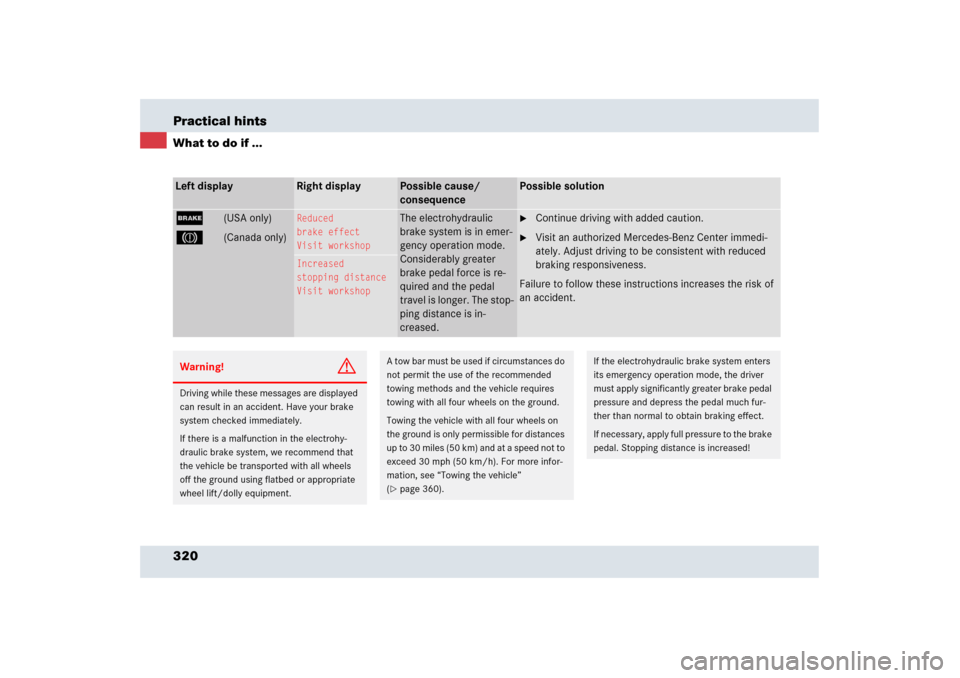
320 Practical hintsWhat to do if ...Left display
Right display
Possible cause/
consequence
Possible solution
;
(USA only)
3
(Canada only)
Reduced
brake effect
Visit workshop
The electrohydraulic
brake system is in emer-
gency operation mode.
Considerably greater
brake pedal force is re-
quired and the pedal
travel is longer. The stop-
ping distance is in-
creased.
�
Continue driving with added caution.
�
Visit an authorized Mercedes-Benz Center immedi-
ately. Adjust driving to be consistent with reduced
braking responsiveness.
Failure to follow these instructions increases the risk of
an accident.
Increased
stopping distance
Visit workshop
Warning!
G
Driving while these messages are displayed
can result in an accident. Have your brake
system checked immediately.
If there is a malfunction in the electrohy-
draulic brake system, we recommend that
the vehicle be transported with all wheels
off the ground using flatbed or appropriate
wheel lift/dolly equipment.
A tow bar must be used if circumstances do
not permit the use of the recommended
towing methods and the vehicle requires
towing with all four wheels on the ground.
Towing the vehicle with all four wheels on
the ground is only permissible for distances
up to 30 miles (50 km) and at a speed not to
exceed 30 mph (50 km/h). For more infor-
mation, see “Towing the vehicle”
(�page 360).
If the electrohydraulic brake system enters
its emergency operation mode, the driver
must apply significantly greater brake pedal
pressure and depress the pedal much fur-
ther than normal to obtain braking effect.
If necessary, apply full pressure to the brake
pedal. Stopping distance is increased!
Page 336 of 409
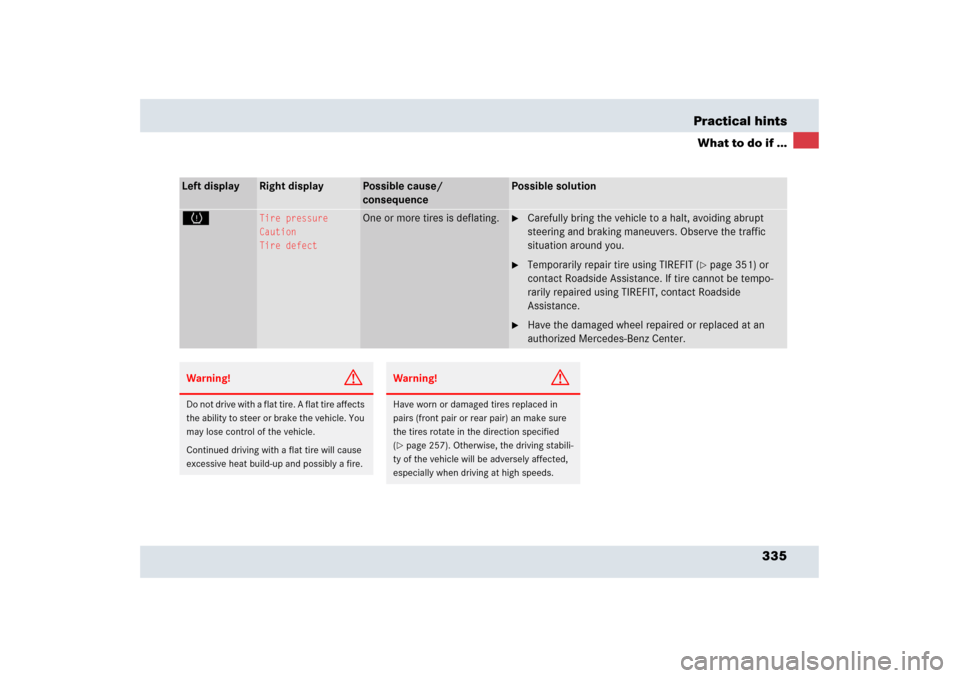
335 Practical hints
What to do if ...
Left display
Right display
Possible cause/
consequence
Possible solution
H
Tire pressure
Caution
Tire defect
One or more tires is deflating.
�
Carefully bring the vehicle to a halt, avoiding abrupt
steering and braking maneuvers. Observe the traffic
situation around you.
�
Temporarily repair tire using TIREFIT (
�page 351) or
contact Roadside Assistance. If tire cannot be tempo-
rarily repaired using TIREFIT, contact Roadside
Assistance.
�
Have the damaged wheel repaired or replaced at an
authorized Mercedes-Benz Center.
Warning!
G
Do not drive with a flat tire. A flat tire affects
the ability to steer or brake the vehicle. You
may lose control of the vehicle.
Continued driving with a flat tire will cause
excessive heat build-up and possibly a fire.
Warning!
G
Have worn or damaged tires replaced in
pairs (front pair or rear pair) an make sure
the tires rotate in the direction specified
(�page 257). Otherwise, the driving stabili-
ty of the vehicle will be adversely affected,
especially when driving at high speeds.
Page 337 of 409
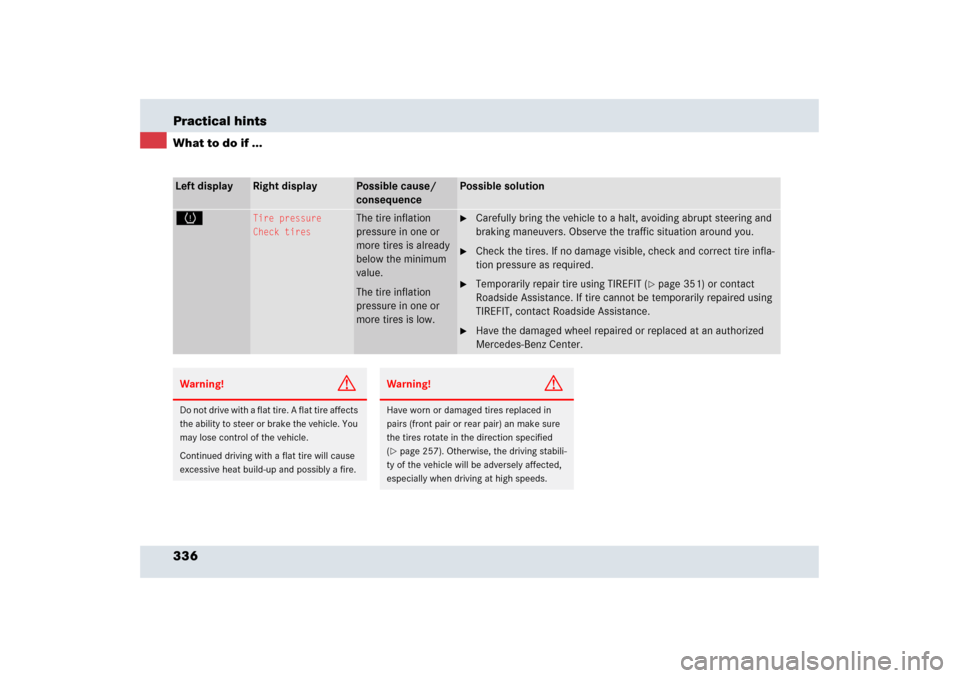
336 Practical hintsWhat to do if ...Left display
Right display
Possible cause/
consequence
Possible solution
H
Tire pressure
Check tires
The tire inflation
pressure in one or
more tires is already
below the minimum
value.
The tire inflation
pressure in one or
more tires is low.
�
Carefully bring the vehicle to a halt, avoiding abrupt steering and
braking maneuvers. Observe the traffic situation around you.
�
Check the tires. If no damage visible, check and correct tire infla-
tion pressure as required.
�
Temporarily repair tire using TIREFIT (
�page 351) or contact
Roadside Assistance. If tire cannot be temporarily repaired using
TIREFIT, contact Roadside Assistance.
�
Have the damaged wheel repaired or replaced at an authorized
Mercedes-Benz Center.
Warning!
G
Do not drive with a flat tire. A flat tire affects
the ability to steer or brake the vehicle. You
may lose control of the vehicle.
Continued driving with a flat tire will cause
excessive heat build-up and possibly a fire.
Warning!
G
Have worn or damaged tires replaced in
pairs (front pair or rear pair) an make sure
the tires rotate in the direction specified
(�page 257). Otherwise, the driving stabili-
ty of the vehicle will be adversely affected,
especially when driving at high speeds.
Page 338 of 409

337 Practical hints
What to do if ...
Left display
Right display
Possible cause/
consequence
Possible solution
H
Tire pressure, FL
Caution
Tire defect
The left front tire is
deflating.
�
Carefully bring the vehicle to a halt, avoiding abrupt steering and
braking maneuvers. Observe the traffic situation around you.
�
Temporarily repair tire using TIREFIT (
�page 351) or contact
Roadside Assistance. If tire cannot be temporarily repaired using
TIREFIT, contact Roadside Assistance.
�
Have the damaged wheel repaired or replaced at an authorized
Mercedes-Benz Center.
Tire pressure, FL
Check
tires
The left front tire in-
flation pressure is
low.
�
Carefully bring the vehicle to a halt.
�
Check the tires. If no damage visible, check and correct tire infla-
tion pressure as required.
�
If necessary, have the wheel repaired or replaced at an authorized
Mercedes-Benz Center.
Warning!
G
Do not drive with a flat tire. A flat tire affects
the ability to steer or brake the vehicle. You
may lose control of the vehicle.
Continued driving with a flat tire will cause
excessive heat build-up and possibly a fire.
Warning!
G
Have worn or damaged tires replaced in
pairs (front pair or rear pair) an make sure
the tires rotate in the direction specified
(�page 257).
Otherwise, the driving stability of the vehicle
will be adversely affected, especially when
driving at high speeds.
Page 339 of 409
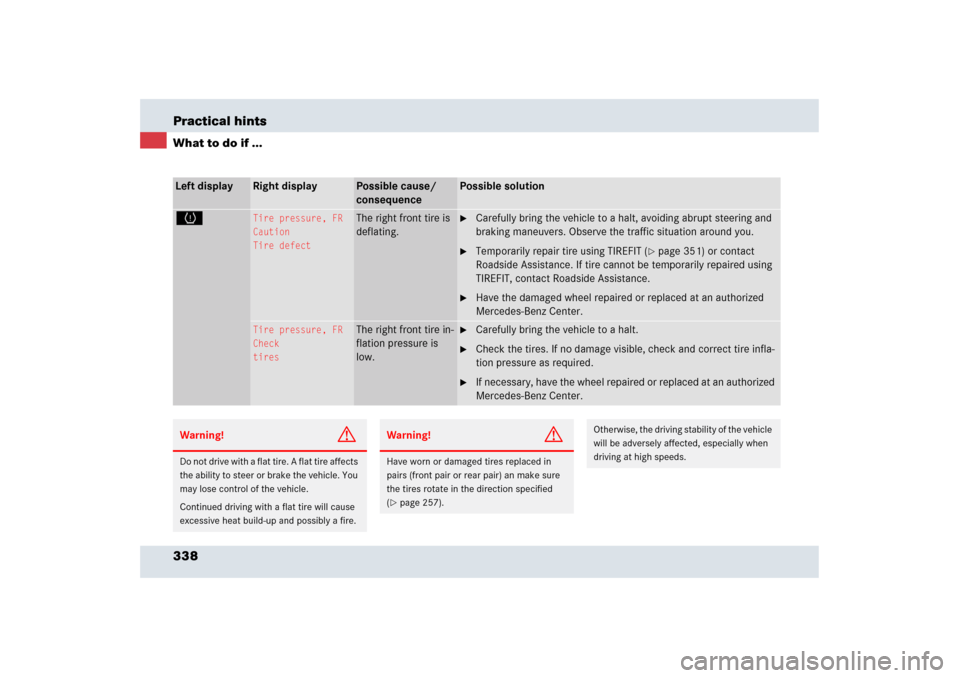
338 Practical hintsWhat to do if ...Left display
Right display
Possible cause/
consequence
Possible solution
H
Tire pressure, FR
Caution
Tire defect
The right front tire is
deflating.
�
Carefully bring the vehicle to a halt, avoiding abrupt steering and
braking maneuvers. Observe the traffic situation around you.
�
Temporarily repair tire using TIREFIT (
�page 351) or contact
Roadside Assistance. If tire cannot be temporarily repaired using
TIREFIT, contact Roadside Assistance.
�
Have the damaged wheel repaired or replaced at an authorized
Mercedes-Benz Center.
Tire pressure, FR
Check
tires
The right front tire in-
flation pressure is
low.
�
Carefully bring the vehicle to a halt.
�
Check the tires. If no damage visible, check and correct tire infla-
tion pressure as required.
�
If necessary, have the wheel repaired or replaced at an authorized
Mercedes-Benz Center.
Warning!
G
Do not drive with a flat tire. A flat tire affects
the ability to steer or brake the vehicle. You
may lose control of the vehicle.
Continued driving with a flat tire will cause
excessive heat build-up and possibly a fire.
Warning!
G
Have worn or damaged tires replaced in
pairs (front pair or rear pair) an make sure
the tires rotate in the direction specified
(�page 257).
Otherwise, the driving stability of the vehicle
will be adversely affected, especially when
driving at high speeds.
Page 340 of 409
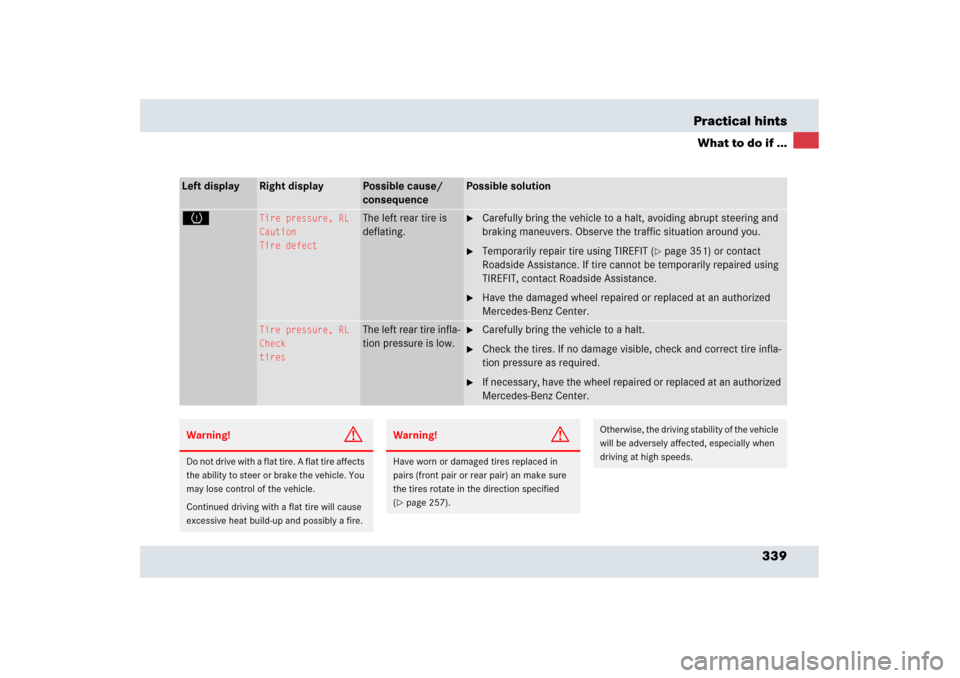
339 Practical hints
What to do if ...
Left display
Right display
Possible cause/
consequence
Possible solution
H
Tire pressure, RL
Caution
Tire defect
The left rear tire is
deflating.
�
Carefully bring the vehicle to a halt, avoiding abrupt steering and
braking maneuvers. Observe the traffic situation around you.
�
Temporarily repair tire using TIREFIT (
�page 351) or contact
Roadside Assistance. If tire cannot be temporarily repaired using
TIREFIT, contact Roadside Assistance.
�
Have the damaged wheel repaired or replaced at an authorized
Mercedes-Benz Center.
Tire pressure, RL
Check
tires
The left rear tire infla-
tion pressure is low.
�
Carefully bring the vehicle to a halt.
�
Check the tires. If no damage visible, check and correct tire infla-
tion pressure as required.
�
If necessary, have the wheel repaired or replaced at an authorized
Mercedes-Benz Center.
Warning!
G
Do not drive with a flat tire. A flat tire affects
the ability to steer or brake the vehicle. You
may lose control of the vehicle.
Continued driving with a flat tire will cause
excessive heat build-up and possibly a fire.
Warning!
G
Have worn or damaged tires replaced in
pairs (front pair or rear pair) an make sure
the tires rotate in the direction specified
(�page 257).
Otherwise, the driving stability of the vehicle
will be adversely affected, especially when
driving at high speeds.